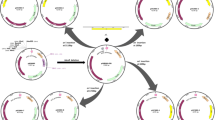Abstract
A double mutant (JH103K10) was created from hydrogenase constitutive mutant (JH103) by replacement of a chromosomal 0.60 kb nickel metabolism related locus with a kanamycin resistance gene. The double mutant required 10 to 20 times more nickel (Ni) to achieve near parental strain levels of hydrogenase activity. In the absence of nickel, both JH103K10 and JH103 synthesized high levels of (inactive) hydrogenase apoprotein (large subunit, 65 kDa). With nickel, the double mutant JH103K10 synthesized the same level of hydrogenase apoenzyme (65-kDa subunit) as the JH103 parent strain; however, whole cell hydrogenase activity in JH103K10 was less than half of that in JH103, and the CPM (due to 63Ni in hydrogenase) of membranes and the calculated ratio of nickel per unit of hydrogenase enzyme of the double mutant were 40% of that in JH103. Therefore, the difference in hydrogenase activities between the double mutant and the Hupck strain can be accounted for by different abilities of the strains to incorporate nickel into the hydrogenase apoenzyme. The addition of nickel ions to previously Ni-starved and then chloramphenicol-treated Bradyrhizobium japonicum whole cells (JH103 and JH103K10) resulted in (an in vivo) restoration of hydrogenase activity, suggesting that the apoprotein synthesized in the Ni-free cultures could be activated by addition of nickel even in the absence of protein synthesis. The extent of reconstitution of active hydrogenase by nickel was greater in the absence of chloramphenicol. Hydrogenase apoprotein could not be activated by nickel in vitro even with the addition of ATP. The successful in vivo but not in vitro results suggest that enzymatic but cell-disruption labile factors are required for Ni incorporation into hydrogenase.
Similar content being viewed by others
References
Arp DJ (1985) Rhizobium japonicum hydrogenase: purification to homogeneity from soybean nodules and molecular characterization. Arch Biochem Biophys 237: 504–512
Bast E (1988) Nickel requirement for the formation of active urease in purple sulfur bacteria (Chromatiaceae). Arch Microbiol 150: 6–10
Bishop PE, Guevarra JG, Engelke JA, Evans HJ (1976) Relations between glutamine synthetase and nitrogenase activities in the symbiotic associations between Rhizobium japonicum and Glycine max. Plant Physiol 57: 542–546
Dixon NE, Grazzola C, Asher CJ, Lee DSW, Blakeley RL, Zerner B (1980) Jack bean urease (EC 3.5.1.5). II. The relationship between nickel, enzymatic activity, and the “abnormal” ultraviolet spectrum. Can J Biochem 58: 474–480
Eskew LE, Welch RM, Cary EE (1984) A simple plant nutrient solution purifications method for effective removal of trace metals using controlled probe glass-8-hydroxyquinoline chelation column chromatography. Plant Physiol 76: 103–105
Fu C, Maier RJ (1991) Identification of a locus within the hydrogenase gene cluster involved in intracellular nickel metabolism in Bradyrhizobium japonicum. Appl Environ Microbiol 57: 3502–3510
Graham LA, Stults LW, Maier RJ (1984) Nitrogenase-hydrogenase relationships in Rhizobium japonicum. Arch Microbiol 140: 243–246
Harker AR, Xu LS, Hanus FJ, Evans HJ (1984) Some properties of the nickel-containing hydrogenase of chemolithtrophically grown Rhizobium japonicum. J Bacteriol 159: 850–856
Hausinger RF (1987) Nickel utilization by microorganisms. Microbiol Rev 51: 22–42
Imperial J, Ugalde RA, Shah VK, Brill WJ (1984) Role of the nif Q gene product in the incorporation of molybdenum into nitrogenase in Klebsiella pneumoniae. J Bacteriol 158: 187–194
Johnson DA, Gautsch JW, Sportman JR, Elder JH (1984) Improved technique utilizing nonfat dry milk for analysis of proteins and nucleic acids transferred to nitrocellulose. Gene Anal Tech 1: 3–8
Kim H, Maier RJ (1990) Transcriptional regulation of hydrogenase synthesis by nickel in Bradyrhizobium japonicum. J Biol Chem 265: 18729–18732
Kim H, Yu C, Maier RJ (1991) Common cis-acting region responsible for transcriptional regulation of Bradyrhizobium japonicum hydrogenase by nickel, oxygen, and hydrogen. J Bacteriol 173: 3993–3999
Laemmli UK (1970) Cleavage of structural proteins during the assembly of the head of bacteriophage T4. Nature 227: 680–685
Lee MN, Mulrooney SB, Hausinger RP (1990) Purification, characterization, and in vivo reconstitutions of Klebsiella aerogenes urease apoenzyme. J Bacteriol 172: 4427–4431
Mackerras AH, Smith GD (1986) Urease activity of the cyanobacterium Anabaena cylindrica. J Gen Microbiol 132: 2749–2752
Maier RJ, Hanus FJ, Evans HJ (1979) Regulation of hydrogenase in Rhizobium japonicum. J Bacteriol 137: 824–829
Maier RJ, Pihl TD, Stults L, Sray W (1990) Nickel accumulation and storage in Bradyrhizobium japonicum. Appl Environ Microbiol 56: 1905–1911
Maier RJ, Postgate JR, Evans HJ (1978) Rhizobium japonicum mutants unable to use H2. Nature 276: 494–496
Merberg D, O'Hara EB, Maier RJ (1983) Regulation of hydrogenase in Rhizobium japonicum: analysis of mutants altered in regulation by carbon substrates and oxygen. J Bacteriol 156: 1236–1242
Moshiri F, Maier RJ (1988) Conformational changes in the membrane-bound hydrogenase of Bradyrhizobium japonicum. J Biol Chem 263: 17809–17816
Novak PD, Maier RJ (1987) Inhibition of hydrogenase synthesis by DNA gyrase inhibitors in Bradyrhizobium japonicum. J Bacteriol 169: 2708–2712
Novak PD, Maier RJ (1989) Hydrogenase synthesis in Bradyrhizobium japonicum Hupc mutants is altered in sensitivity to DNA gyrase inhibitors. Appl Environ Microbiol 55: 1157–1164
Rees TAV, Bekheet IA (1982) The role of nickel in urea assimilation by algae. Planta 156: 385–387
Stults LW, Moshiri F, Maier RJ (1986) Aerobic purification of hydrogenase from Rhizobium japonicum by affinity chromatography. J Bacteriol 166: 795–800
Stults L, O'Hara E, Maier RJ (1984) Nickel is a component of hydrogenase in Rhizobium japonicum. J Bacteriol 159: 153–158
Towbin H, Staehelin T, Gordon J (1979) Electrophoretic transfer of proteins from polyacrylamide gels to nitrocellulose sheets: procedure and some applications. Proc Natl Acad Sci USA 76: 4350–4354
Wang RT (1980) Amperometric hydrogen electrode. Methods Enzymol 69: 409–412
Winkler RG, Polacco JC, Eskew DL, Welch RM (1983) Nickel is not required for apourease synthesis in soybean seeds. Plant Physiol 72: 262–263
Author information
Authors and Affiliations
Rights and permissions
About this article
Cite this article
Fu, C., Maier, R.J. Nickel-dependent reconstitution of hydrogenase apoprotein in Bradyrhizobium japonicum Hupc mutants and direct evidence for a nickel metabolism locus involved in nickel incorporation into the enzyme. Arch. Microbiol. 157, 493–498 (1992). https://doi.org/10.1007/BF00276768
Received:
Accepted:
Issue Date:
DOI: https://doi.org/10.1007/BF00276768




